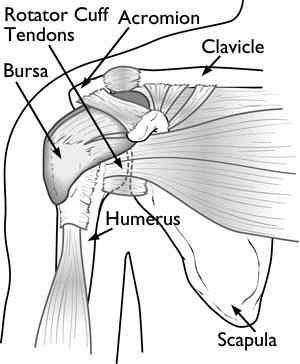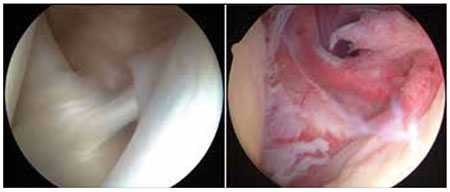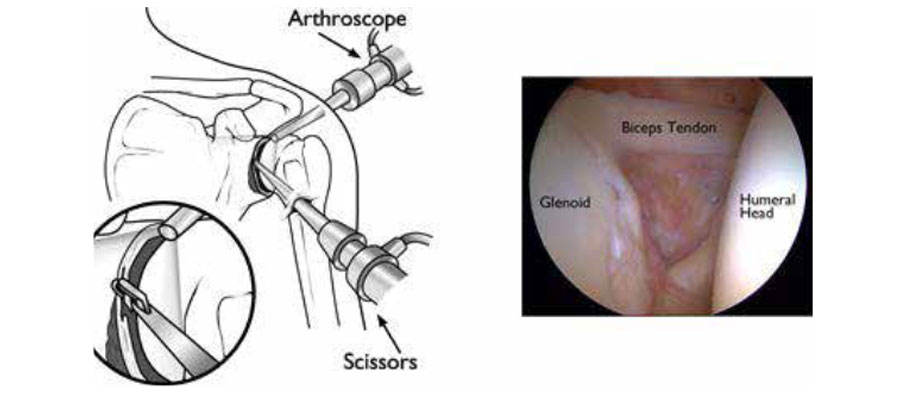Arthroscopy is a procedure that orthopaedic surgeons use to inspect, diagnose, and repair problems inside a joint.
During shoulder arthroscopy, your surgeon inserts a small camera, called an arthroscope, into your shoulder joint. The camera displays pictures on a television screen, and your surgeon uses these images to guide miniature surgical instruments.
Because the arthroscope and surgical instruments are thin, your surgeon can use very small incisions (cuts), rather than the larger incision needed for standard, open surgery. This results in less pain for patients, and shortens the time it takes to recover and return to favourite activities.
ANATOMY
Your shoulder is a complex joint that is capable of more motion than any other joint in your body. It is made up of three bones: your upper arm bone (humerus), your shoulder blade (scapula), and your collarbone (clavicle).

WHEN IS SHOULDER ARTHROSCOPY RECOMMENDED?
Your doctor may recommend shoulder arthroscopy if you have a painful condition that does not respond to conservative treatment. Conservative treatment includes rest, manual therapy such as physiotherapy or osteopathy, acupuncture and medications or injections that can reduce inflammation. Inflammation is one of your body’s normal reactions to injury or disease. In an injured or diseased shoulder joint, inflammation causes swelling, pain, and stiffness.
Injury, overuse, and age-related wear and tear are responsible for most shoulder problems. Shoulder arthroscopy may relieve painful symptoms of many problems that damage the rotator cuff tendons, labrum, articular cartilage, and other soft tissues surrounding the joint.
Common arthroscopic procedures include:
- Rotator cuff repair
- Bone spur removal
- Removal or repair of the labrum
- Repair of ligaments
- Removal of inflamed tissue or loose cartilage
- Repair for recurrent shoulder dislocation.
Less common procedures such as nerve release, fracture repair, and cyst excision can also be performed using an arthroscope. Some surgical procedures, such as shoulder replacement, still require open surgery with more extensive incisions.
These photos taken through an arthroscope show a normal shoulder joint lining.

PLANNING FOR SURGERY
Your orthopaedic surgeon will review your medical and surgical history, including current medications to make sure that you do not have any medical problems that need to be addressed before your surgery. Blood tests, an electrocardiogram, or chest X-ray may be needed to safely perform your surgery.
If you have certain health risks, a more extensive evaluation may be necessary before your surgery. Be sure to inform your orthopaedic surgeon of any medications or supplements that you take. You may need to stop taking some of these prior to surgery.
The orthopaedic surgeon will explain you the specific details about your procedure. Make sure to follow the instructions on when to arrive and especially on when to stop eating or drinking prior to your surgery.
You will be asked to sign a consent form that says you understand the risks of arthroscopy and agree to have the procedure done. Talk to your doctor about any concerns you have regarding the need for the procedure, its risks, how it will be done.
Before the operation, the anaesthetist will talk with you about anaesthesia options. Many surgeons combine nerve blocks with sedation or a light general anaesthetic because patients can become uncomfortable staying in one position for the length of time needed to complete the surgery.
Most arthroscopic procedures take round about an hour; however, the length of your surgery will depend on what your surgeon finds and what repairs are required.
PROCEDURE
Your surgeon will first inject fluid into the shoulder to inflate the joint. This makes it easier to see all the structures of your shoulder through the arthroscope. Then your surgeon will make a small puncture in your shoulder (about the size of a buttonhole) for the arthroscope. Fluid flows through the arthroscope to keep the view clear and control any bleeding. Images from the arthroscope are projected on the video screen showing your surgeon the inside of your shoulder and any damage.

Once the problem is clearly identified, your surgeon will insert other small instruments through separate incisions to repair it. Specialised instruments are used for tasks like shaving, cutting, grasping, suture passing, and knot tying. In many cases, special devices are used to anchor stitches into bone.

RECOVERY
Postoperative
After surgery, you will stay in the recovery room for one to two hours before being transferred to the ward. Nurses will monitor your responsiveness and provide pain medication, if needed. During your hospital stay, usually one to two days, you will start physiotherapy including cold therapy and specific guidance from your physiotherapist to help you to prepare you returning back home.
At home
Although recovery from arthroscopy is often faster than recovery from open surgery, it may still take weeks or months for your shoulder joint to completely recover.
You can expect some pain and discomfort for at least a week after surgery. If you have had a more extensive surgery, however, it may take several weeks before your pain subsides. Ice will help relieve pain and swelling. Your doctor may prescribe pain medicine, if needed.
You will most likely need a sling or special immobiliser to protect your shoulder. Your surgeon will discuss with you how long the sling will be needed.
Rehabilitation
Following shoulder surgery, rehabilitation plays an important role in getting you back to your daily activities. Based on your surgical procedure, your surgeon will recommend you to start physiotherapy as soon as possible. Your physiotherapist will provide guidance on pain and swelling management. He/ she will also give you a progression of exercises which will help you regain shoulder strength and motion. Guidance would be also provided to perform your activities of daily living such as dressing, shower, working, driving etc.
COMPLICATIONS
Most patients do not experience complications from shoulder arthroscopy. As with any surgery, however, there are some risks. These are usually minor and treatable. Potential problems with arthroscopy include infection, excessive bleeding, blood clots, and damage to blood vessels or nerves.
Your surgeon will discuss the possible complications with you before your operation.
OUTCOMES
Because patients have varied health conditions, complete recovery time is different for everyone.
If you have had a minor repair, you may not need a sling and your strength may return after a short period of rehabilitation. You may be able to return to work or school within a few days of your procedure.
It takes longer to recover from more complicated procedures. Although the incisions are small in arthroscopy, extensive damage within the joint can be repaired with the procedure. Full recovery may take several months. Although it can be a slow process, following your surgeon’s guidelines and rehabilitation plan is vital to a successful outcome.
Sources: “the American Academy of Orthopaedics Surgeons”.



